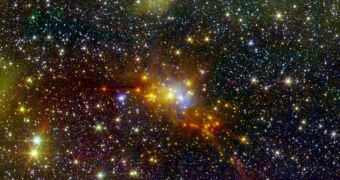If there is one thing NASA brainiacs love and adore, this thing is using high-tech gadgets and gizmos to peek into the wonders of the universe. Luckily for us, ordinary folks, they are more than willing to share their findings.
The image above has only recently hit the public eye. It shows a cluster of newborn stars in the Serpens Cloud Core in the Serpens constellation, and it was obtained with the help of the Spitzer Space Telescope.
According to Space, the baby stars featured in this image are the ones sporting the colors red, orange, and yellow. The cloud of excess gas in their proximity appears in blue, the same source details.
By the looks of it, NASA (that's the National Aeronautics and Space Administration in the United States, in case anyone was wondering what the initials stand for) put quite a lot of effort into creating this view of the cluster of baby stars.
Thus, information shared with the public says that the image comprises as many as 82 views of the baby stars that the Spitzer Space Telescope obtained while stalking the Serpens Cloud Core for about 16 hours straight.
As if these 82 views were not enough, specialists working with NASA also used information obtained while carrying out an infrared survey of the sky, i.e. the Two Micron All Sky Survey, to create this image of the cluster.
Astronomers explain that the reason why this cluster of newborn stars is present in the Serpens Cloud Core is because this part of the Serpens constellation is a stellar nursery. Unlike other stellar nurseries in the Milky Way, this region only comprises small stars.
What's more, evidence at hand indicates that stars in the Serpens Cloud Core are among the youngest to have until now been spotted and documented in our entire galaxy. The trouble is that, because of the clouds of dust around them, these stars are not easy to spot.
This is despite the fact that, when one takes into account just how ginormous the universe it, the Serpens Galaxy is not even all that far from us. On the contrary, it sits at a distance of just 750 light-years from our planet.
The Spitzer Space Telescope solves this problem by collecting and processing longer, invisible wavelengths of light in the infrared spectrum that other telescopes would be unable to pick up on, NASA researchers explain.
Then again, Spitzer did cost $800 million (approximately €586 million) to make, so it is no wonder it is always hard at work and looking not to disappoint its makers and chaperons.

 14 DAY TRIAL //
14 DAY TRIAL //